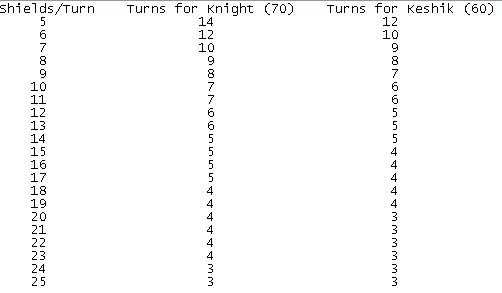The Mongol civ traits are widely considered to be some of the weaker ones in Civ3; expansionist can be powerful given a map with a great deal of land and lots of goody huts to pop, but it can also be quite useless on other map types. Militaristic is of course useful in promoting more units and giving shield discounts on some buildings, but the two traits do not generally combine very well. With normal speed workers and no shield discounts on any cultural buildings, the Mongols will have their work cut out for them in playing any kind of a peaceful game.
The Keshik is a different issue than the Mongol civ traits altogether. It's been widely derided as a "useless" unique unit, with many different people calling it actually worse than the knight it replaces, but there are some very positive features to the keshik. The first is its "mountainwalk" ability, or the ability to travel over mountains as though they were plains. While not game-breakingly powerful, I have found that this actually comes into play more often than you would think. Oftentimes a crafty player can park keshiks on top of mountain ranges at the end of a turn, where their defense is as good as a samurai (4). Sometimes you can also hit a city which would be otherwise unreachable through the use of this novel trait. On the whole though, it's not an ability which is anything to get too excited about.
What IS significant about the keshik is that it costs fewer shields to build than a knight, 60 shields versus 70. That sounds like a paltry difference, but looking more closely at the way that cities produce units shows that ten shields can have a very big effect. The key thing in producing units is not how many shields they cost, but how many turns it takes to produce the unit. When the math is computed out, it turns out that a keshik takes a full turn less to complete than a knight in virtually every single case that pops up. Take a look:
(I'm not good at formatting tables so I just uploaded a picture.

) A keshik is NOT simply 6/7 the cost of a knight; it depends entirely on how many shields the city working on the unit is producing. For a city at 10 shields/turn, the keshik is indeed 6/7 the cost. But for a city at 15 shields/turn the keshik is 4/5 the cost, and for a city at 20 shields/turn, it is 3/4 of the cost. That's 25% - a BIG difference! Not trivial at all. Of course, for a city making 14, 18, or 19 shields/turn there is no difference at all in cost between the two units; a good reason why you should manage your cities closely!

So in reality, keshiks are often considerably cheaper than knights, meaning you can expect on average to have about 20% more keshiks than knights. If you don't think that's a significant difference, just remember that the next time you come up "one unit short" of taking a city.
Bottom line is that the keshik's cheaper cost easily tends to make up for its lowered defense. It's a tradeoff to be sure, but frequently one that you can use to your advantage. Just be sure not to leave keshiks unguarded out in the open at the end of a turn. I hope this was helpful.
EDIT: And just to set the record straight, Ghenghis Khan Temujin and the Mongols emerged into the light of history during the late 12th and early 13th century. That was almost 1000 years after the fall of the western half of the Roman Empire. A number of barbarian tribes had a hand in bringing down the Roman Empire, but the Mongols were most definitely not one of them. The Mongols destroyed empires in China, Central Asia, Russia, and Iraq but the Romans were not among that group.



 ) A keshik is NOT simply 6/7 the cost of a knight; it depends entirely on how many shields the city working on the unit is producing. For a city at 10 shields/turn, the keshik is indeed 6/7 the cost. But for a city at 15 shields/turn the keshik is 4/5 the cost, and for a city at 20 shields/turn, it is 3/4 of the cost. That's 25% - a BIG difference! Not trivial at all. Of course, for a city making 14, 18, or 19 shields/turn there is no difference at all in cost between the two units; a good reason why you should manage your cities closely!
) A keshik is NOT simply 6/7 the cost of a knight; it depends entirely on how many shields the city working on the unit is producing. For a city at 10 shields/turn, the keshik is indeed 6/7 the cost. But for a city at 15 shields/turn the keshik is 4/5 the cost, and for a city at 20 shields/turn, it is 3/4 of the cost. That's 25% - a BIG difference! Not trivial at all. Of course, for a city making 14, 18, or 19 shields/turn there is no difference at all in cost between the two units; a good reason why you should manage your cities closely!  So in reality, keshiks are often considerably cheaper than knights, meaning you can expect on average to have about 20% more keshiks than knights. If you don't think that's a significant difference, just remember that the next time you come up "one unit short" of taking a city.
So in reality, keshiks are often considerably cheaper than knights, meaning you can expect on average to have about 20% more keshiks than knights. If you don't think that's a significant difference, just remember that the next time you come up "one unit short" of taking a city. 
